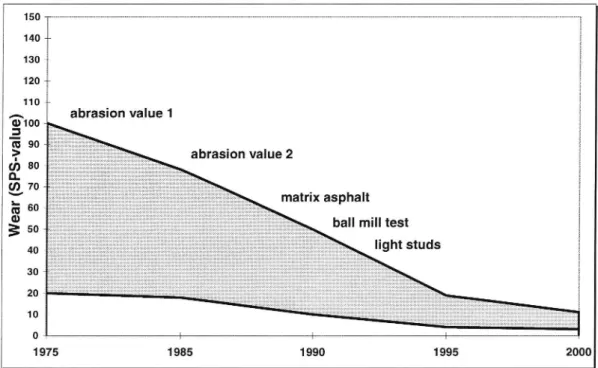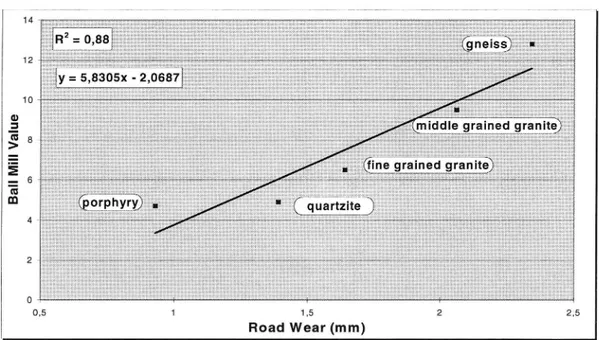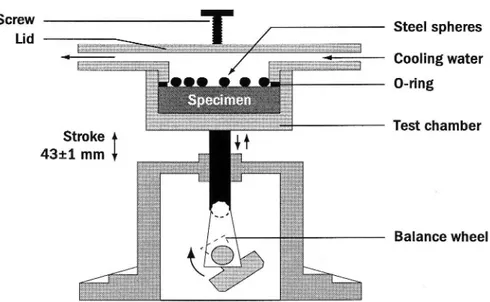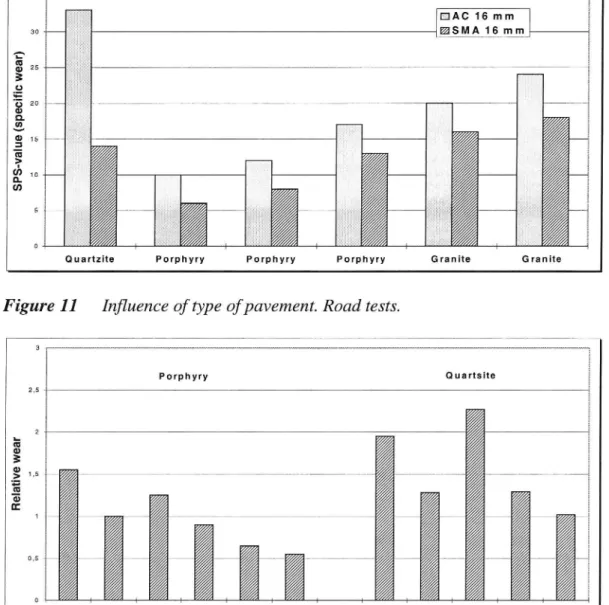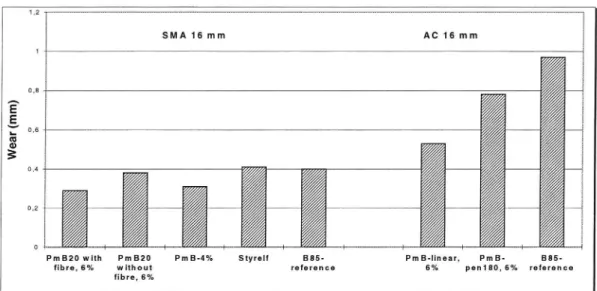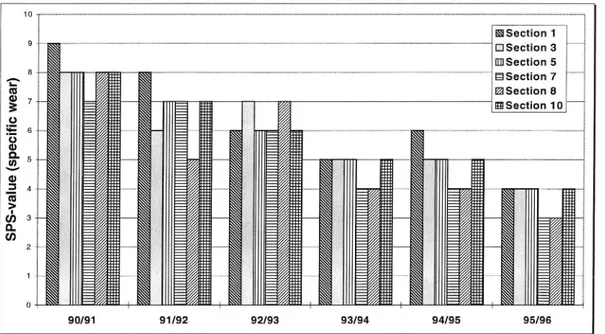[F-> © © C 1>] rljaud © man VTl notat 30-1997
The wear resistance of
bituminous mixes to studded
tyres - the Swedish
experience
Paper at the Fifth International Symposium on Cold Region Development, Anchorage, Alaska, USA
Författare Torbjörn Jacobson
Programområde Konstruktion & Byggande
Projektnummer 12012 Projektnamn Konferenser Uppdragsgivare VTI Distribution Fri Väg- och transport-forskningsinstitutet ä
CONTENTS
INTRODUCTION... .. 2
METHODS FOR MEASURING THE WEAR RESISTANCE OF
AGGREGATES ... 3
METHODS/EQUIPMENT FOR MEASURING THE WEAR
RESISTANCE OF ASPHALT SURFACING MIXES ... .. 4
FACTORS INFLUENCING STUD WEAR ... .. 7
FORECAST MODEL FOR WEAR FROM STUDDED TYRES ... .. 9
EXPERIENCE FROM TEST ROADS ... 9
CONCLUSIONS ... .. 10
LITERATURE ... .. 11
INTRODUCTION
In Sweden, studded tyres are used in the winter, causing considerable surface wear on roads with high traffic volumes thus resulting in rutting. For a long period, the VTI (Swedish National Road and Transport Research Institute) has been working on the development of wear-resistant asphalt pavements and equipment/methods for measuring the wear resistance of aggregates and asphalt surfacings. The choice of wear-resistant aggregates, introduction of stone-matrix asphalt and a change
towards studded tyres, more favourable to the pavement, resulted in a considerable reduction of stud wear (Figure 1), which is now on an acceptable level. VTI
activities have been carried out as follows:
development of test equipment and measurement methods for wear studies a survey of influencing factors
a survey and estimation of various pavement (surfacing) types
development of a forecast model for rutting, cross-profile and annual costs based on the wear caused by studded tyres
150 140 130 120 110 -9 _ A0100 abrasmn value 1 .3.0: 90 _ ? abrasmn value 2 a) 80 n. g 70 _ L matrix asphalt m 60 m . g 50 ball mlll test 40 light studs 30 20 10 H 0 l I 1975 1985 1990 1995 2000
Figure 1 Wear development on roads with high traffic volumes, in principle,
and development of test methods and mix types. (SPS-value = wear in gram per vehicle and kilometre).
METHODS FOR MEASURING THE WEAR RESISTANCE OF
AGGREGATES
At an early stage, the interest was focused on the quality of the aggregate and test methods were designed. The abrasion value (related to the British test) and later the "Nordic" wet ball mill value (Figure 2) are such examples. The correlation between the "Nordic" wet ball mill value and road wear is shown in Figure 3. In recent years, the wet ball mill test has also become a Nordic method and has been proposed as a European test method in the harmonisation of standards in Europe.
Figure 2 One type of equipment for determining the "Nordic" wet ball mill value.
middle gralned granlte
Ba ll Mi ll Va lue 0,5 1 1,5 Road Wear (mm)
Figure 3 Correlation between the "Nordic" ball mill test and road wear.
METHODS/EQUIPMENT FOR MEASURING THE WEAR RESISTANCE
OF ASPHALT SURFACING MIXES
The design of laboratory methods measuring the wear resistance of asphalt specimens proved to be difficult, which resulted in the activities being concentrated on road tests. At the beginning of the 903, there was however a breakthrough thanks to new test methods where small slabs of asphalt mixes were tested thoroughly and in realistic conditions. The slabs can be tested either in the field (Figure 4) by placing them in existing pavements and measuring the wear from traffic or by performing accelerated tests in the VTI's road simulator (a circular machine with a diameter of five metres) Figure 5. The method of using test slabs has facilitated a systematic survey of the factors influencing stud wear. Since the start at the end of the 1980's, approximately 600 slabs have been tested.
Initially, the slabs were tested in the road, but in the course oftime, most of the
tests have been moved to the road simulator, which is now the most important method for wear studies. This has been possible because of the very high
correlation between the road simulator and road wear (Figure 6).
Wear measurements in the field and in the road simulator were carried out with a laser profilometer (Figure 7a) consisting of an approximately one metre long monitoring beam with support. The profilometer is based on non-contact distance measurements between the measurement beam and the road surface using laser technique. The crossprofile is registered with a reading precision of approximately 0.01 mm and with a sampling density of 400 measurement points per metre. The measurement data are stored and processed in a PC. Wear is calculated from the difference between the zero measurement and the final measurement which is carried out in the autumn and spring, respectively, just before and after the period
with studded tyres (Figure 7b).
In recent years, a laboratory method, Prall test (Figure 8), has been modified for
wear tests of specimens and drill cores. The method means placing a specimen in a small chamber with a number of small steel balls. The chamber is then shaken up and down at a high frequency and the steel balls hit the lid and the specimen and material from the specimen is worn off. The method originates from California (for durability resistance testing) and was later introduced to Germany.
Figure 4 Wear measurements 0f test slabs in thefield.
Figure 5 VTI's road simulator, PVM.
2,5 y :1,0481x - 0,0736 N Ro ad Si mul at or (P VM ) 0,5 0,5 Road
Figure 6 Correlation between slabs in the PVM and the road. Type of pavement ABT12/B85 and ABT16/B85
Figure 7a Laserprofilometerfar wear measurements (crossprofiles).
0.0 0.4 0.8 1.2 1.6 2.0 2.4 2.8 3.2 sia 4.0
Profile length (m)
Figure 7b Wear profile (worn material). Screw
Lid
Steel spheres
<---- Cooling water O-ring Test Chamber Stroke 43:1 mm Balance wheel
Figure 8 Principal sketch of the Prall test equipment in Sweden.
FACTORS INFLUENClNG STUD WEAR
Of all the studied parameters, the wear resistance of the coarse aggregate (exceeding 4 or 8 mm size) has proved to have a considerable influence on the wear resistance of the pavement. Figure 9 shows the importance of the aggregate in asphalt concrete with a maximum size of 12 and 16 mm. The difference between the poorest and the best pavement is approximately a factor 3. Figure 10 gives asurvey of how stone-matrix asphalt is influenced by the coarse aggregate. The "Nordic" ball mill value of the pavements is between 4-13.
The proportion of coarse aggregate in the pavement influences stud wear considerably. In principle, pavement resistance to studded tyres increases with increased aggregate content, implying that stone-matrix asphalt has better wear
resistance than dense asphalt concrete (Figure 11). The Swedish stone-matrix
asphalts contain about 70% material exceeding 4 mm.
The maximum aggregate size is another factor of great importance to stud wear. In Figure 12, stone-matrix and dense asphalt concrete with varying aggregate size are described. The aggregates are phorphyry and quartzite.
Polymer modified binders (PMB) can reduce wear from studs on specific types of pavements (Figure 13). Dense asphalt concrete with PmB obtains reduced wear compared with conventional bitumen while stone-matrix asphalt is not influenced by PmB.
Other factors influencing pavement wear are: degree of compaction, traffic
volume and frequency of studs, speed, lateral distribution of traffic (road width),
distribution wet/dry wear and the type of studs, stud protrusion and stud force. Wet wear is often greater than dry wear but the difference depends on the type of
aggregate. AC12 mm AC16 mm
Re al ti ve we ar N
"
Porphyry Quartzite Fine Medium Gneiss Porphyry Quartzite Fine Medium Gneiss
granite granite granite gran'
' :
:- CD
Figure 9 Influence of uggregate quality., Tests in the road simulator.
Figure 12
VTI Notat 30- 1997
Influence of maximum aggregate size. Tests in PVM.
Re la ti ve we ar SP S-va lue (s pe ci fi c we ar ) Re la ti ve we ar o 'm _. L 1 X > m 5% _ ... ... ... ... ... ... ... ... ... ... ... ... ... ... ... ... ... ... ... .. .m .-0 -\' N \
1
1 1 Figure 11 : §§§§§§§§§§§§§§ .-rN 0 0-0 W :J I I I I HI I I I I II I I 'O 0 'l -! '< 'U 'J' '<m : " N X I IN I SMA12mm
/
0H :-um Porphyry m a - m m 'O 0 -| 'U 3' '< q < .u n -::;: 'O 5::-' -:::.:-:-: -:<:-:-:-: -:-:. ..._. .,. I.. .. .... ..Ä' ijii i 5' '<Influence of type Ofpavement. Road tests.
§§§§§§§§§§§
å
g
2
;
-\
\
\
SMA16mm EAC16rnm ZSMA16mm ä0 U I I II H I I II I I I I I\
\\
\\\
\\\
\\\
\
m u: å
Figure 10 Influence of maximum aggregate size. Tests in the road simulator.
\
\\\
\\\
\\\
\\\
\\\
\\\
\\\
\\\
\\\
\\W
SMA16 mm AC16 mm W e a r ( m m )
Figure 13 Influence of modified binders (PMB). Aggregate: quartzite. Road tests.
FORECAST MODEL FOR WEAR FROM STUDDED TYRES
The systematic survey of influencing factors facilitated the development of a forecast model for rutting caused by wear from studded tyres. The medel mainly consists of three parts:
0 a model calculating the amount of wear per number of studded vehicles
0 a model calculating the distribution of wear on the width of the lane (wear profile)
0 a model calculating the annual cost from used material and calculated term of life
The inputs in the model are: the "Nordic" ball mill value, aggregate (>4 mm), maximum aggregate size, traffic volume, stud frequency, wear period, speed, road width, proportion of lightweight studs, salted/unsalted roads and pavement costs (aggregate, bitumen, etc.).
EXPERIENCE FROM TEST ROADS
Continuous studies from test roads have shown that wear has been reduced considerably thanks to the actions taken. The relative wear (SPS value, gram worn material per studded vehicle and kilometre) on a four-lane motorway with a total traffic volume of 60,000 vehicles per day is shown in Figure 14. The speed is 90 km/h and the pavement is stone-matrix asphalt with quartzite and porphyry (the best materials in Sweden). The reduction of the relative wear in recent years mainly depends on the lightweight studs which are more favourable to the pavement. Today, only tyres with lightweight studs are sold on the Nordic market. According to tests in the VTI's road simulator, lightweight studs (<l.4 g) wear approximately half the amount of the earlier steel studs (1.8 g).
10
In the winter 1995/96, rutting was only 1.2-1.4 mm for the road mentioned, although 1,4 million studded vehicles trafficked the test sections. The pavement is calculated to have a life time of 10 years.
Section 1 Section 3 [1]]Section 5 äSection 7 Section 8 ESection 10 SP S-va lue (s pe cifi c we ar ) 90/91 91/92 92/93 93/94 94/95 95/96
Figure 14 Development of relative wear (SPS value) 1990-96. Road tests.
CONCLUSIONS
Aggregate quality is without doubt the specific parameter, together with the amount of coarse aggregate and maximum aggregate size, which is of most importance to the wear-resistance of asphalt pavements to studded tyres. Today, the best pavements in Sweden are probably five times more wear-resistant than the pavements in the mid-80s and possibly up to ten times better than those at the end of the 60s when studded tyres were introduced on the market. The development towards more wear-resistant pavements has been considerable above all in recent years, as a result of increased understanding of the importance of aggregates in bituminous surfacing mixes.
High quality stone-matrix asphalt together with the more lenient lightweight studs has drastically reduced stud wear in Sweden and nowadays wearing coarse layers have acceptable life time terms. Earlier (1989) the cost of pavement wear was calculated to be millions of Swedish Crowns 250-300 annually because of wear from studded vehicles on the Swedish road network.
11
LITERATURE
Gustafson K (in Swedish, Abstract and Summary in English). VTI Rapport 377, Tests with light studs in the VTI s road simulator, 1992.
Jacobson T (in Swedish). VTI Notat V197, Wear Characteristics of asphalt pavements. Tests in the VTI s road simulator and laboratory tests according to TrÖger test and PWR test, 1992.
Jacobson T (in Swedish). VTI Notat V173, Wearing course with polymer modified binders. Test road E3/E18, Orebro-Arboga. Progress report 92.02, 1992. Jacobson T (in English). VTI Särtryck 193, Wear resistance of bituminous mixes to studded tyres - A novel approach to field measurements and correlation with
VTPS traffic simulator, 1993.
Jacobson T (in Swedish, Abstract and Summary in English). VTI Meddelande 732, Study of the resistance of wearing course pavements to studded tyres. Tests in the VTPS road simulator. Final report. 1994.
Jacobson T and Wågberg L-G (in Swedish). VTI Notat 46-1994, Local pavements. Study of the resistance of bituminous mixes to studded tyres in VTPS road
simulator, 1994.
Jacobson T (in English). VTI Särtryck 245, Study of the resistance of bituminous mixes to studded tyres - Test with slabs of bituminous mixes inserted in roads and in the VTIs toad simulator.d tyres - A novel approach to field measurements and
correlation with VTPs traffic simulator, 1995.
Jacobson T and Viman L (in Swedish). VTI Notat 16-1996, Funktionsinriktad
metod för bestämning av nÖtningsresistensen hos asfaltbeläggningar, Prall. 1996. Jacobson T (in Swedish). VTI Notat 64-1996, Study of the resistance of wearing course pavements to studded tyres. Test roads. 1996.
